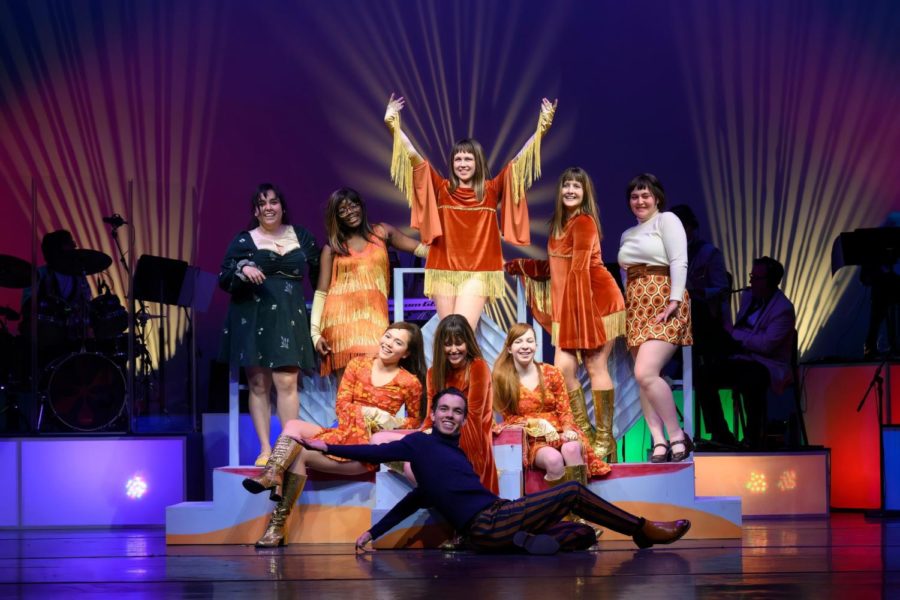“Beehive” centers female empowerment, social movements, music of the ’60s
Director Jenefer Davies called the show “a love letter to girl power”
“Beehive” follows the lives of six young women living through the ’60s. Photo courtesy of the W&L Facebook page
March 28, 2023
Washington and Lee students grooved and jived in the jukebox musical “Beehive: The ’60s Musical” from March 9-11.
“Beehive” tells a story of female empowerment through the chart-topping music of ’60s artists such as Aretha Franklin, Tina Turner and Janis Joplin.
Named after the popular 60s hairstyle, the musical follows six young women as they come of age and navigate the challenges of friendship, adulthood and a changing society.
“Beehive” performer Zaria Daniels, ’26, said the issues presented in the musical maintain relevance despite being set in a past decade. The musical celebrates how far society has come since the 60s while highlighting the problems that still need to be solved.
“A lot of the themes we talk about in the musical surround issues that are still prevalent today,” she said. “During rehearsals, our director would bring up current women’s issues and we’d have discussions comparing them to parts of the show.”
Director Jenefer Davies called the show an energetic “love letter to girl power” in a press release and said that the music of the show, which included “Natural Woman” and “You Don’t Own Me,” enhanced the celebratory message.
“The music the women sing is a shared soundtrack of their lives,” said Davies. “But even as the music evolves throughout the 1960s and the girls themselves grow and change, they accept and love one another. They are the original girl squad.”
The “girl squad” consists of six talented students: Kate Fisher, ’23, Ana Montano Martinez, ’25, Cate Brien, ’26, Elise McPherson, ’26, Meagan Endres, ’26 and Daniels. No one character was the lead. Instead, each member portrayed a different approach to life and supported the others through their unique challenges.
Alec Sirois, ’25, rounded out the cast, playing a DJ whose setlist exposed the girls to music that inspired them.
Montano Martinez said the lively music selection, costumes and fun dances made performing incredibly enjoyable.
“It felt like I just got to play for ninety minutes straight,” said Montano Martinez. “I also think it has a strong positive message about women, and them being independent and powerful. I’m glad people walked out with that message.”
The major events and movements of the 1960s—namely women’s liberation, civil rights, and the assassinations of John F. Kennedy and Rev. Dr. Martin Luther King Jr.—propelled the character’s stories forward.
Daniels, who played Gina, a young Black woman, found that the show’s emphasis on civil rights and female empowerment tied the messages of Black History Month and Women’s History Month together.
“A lot of the songs that we sang were made popular through Black women,” she said. “It’s important that we were able to realize that so many of the iconic songs and rights that we enjoy today wouldn’t have been possible without the work of Black women, and it was an honor to portray artists like Aretha Franklin and sing her songs.”
During set changes, a large, retro-style TV screen directed thes audience’s attention to a montage of famous TV shows and commercials featuring derogatory female stereotypes. The clips reinforced the sexist attitudes of the time period and reminded the audience of the challenges that the characters had to face.
Despite the show’s exploration of serious social topics, the musical contained many funny, light-hearted scenes to showcase the optimism that the characters keep over the years. Even the stage was set with bright colors and vibrant designs that reflected the advent of color television in the 1960s.
The shows’ message of being resilient in volatile times is timeless for performers and audience members alike.
“Nobody knows that they’re in the middle of history while they’re in it,” said Daniels’ character, Gina.




Lee Landers • Apr 1, 2023 at 3:41 pm
This is very well written. I wish I’d been able to see the musical in person.